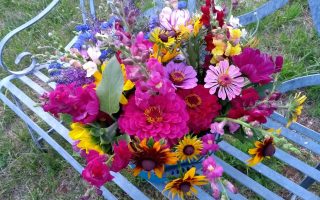September Top Tips For Your Limousin Garden


September, La rentr
September arrives and with it comes the cooler weather. It signals the end to the high heats of July and August. Though, just when you think its safe to put the suntan lotion away; September can and does remind you that it is still a summer month.
September also signals “La Rentrée”, the wonderful way in which France and the French define what I consider to be a more practicable time to have the start of a new year.
After the long lazy summer holiday, for most adults its back to work, for the children its back to school and for the farmers it’s a time to review what has worked well in the ground.
For the gardener it’s also a time to reflect on what has your garden provided you with over the past year and plan what you may want to change or add. Either way, September is not as sleepy as some people think.
The general advice and in particular to a rural region such as the Limousin is the following.
September signals the start of the Hunting season, dates do vary so as always get down to your local Mairie to confirm the official date for your ville/canton. For the newcomers to the region do not be surprised or alarmed to see a single person or a large group of people carrying rifles and shotguns (normally accompanied by a larger group of dogs), trudging very merrily through your vegetables, or, lingering by the side of the road. Welcome to France, they are the Chasse!!!
On a serious note, if you like the country side and want to take full advantage of what it has and what Autumn has to offer in the Limousin. Be aware of where it is safe to walk and also the colour of the clothes you may want to wear. If your land like ours, boarders on to ‘chasse land’ you may want to consider when you carry out work in the garden and again wear bright clothes.
.jpg) To alleviate most of your fears, the chasse is a extremely well organised event, they know which land they can hunt on and subsequently land that cannot be hunted on.
To alleviate most of your fears, the chasse is a extremely well organised event, they know which land they can hunt on and subsequently land that cannot be hunted on.
The hunters themselves are normally all locals who could take you through the land they hunt blindfolded at any time night or day. Apart from gaining a licence to have a firearm, to hunt, the hunter must get a licence. Part of this process is a written and practical exam which requires a high level to be reached to qualify for the licence. To most hunters, upon attaining the licence to hunt, under no circumstances do they want that right to be taken away, hence the serious nature and well organised hunting events that take place in the region. On the occasions that the chasse have crossed our land, it has been with a respect, they have kept as close to the boundary fence as possible and left no damage what so ever in their wake.
Wildlife, apart from trying to hide from the chasse. Wildlife in the area will also begin trying to find suitable accommodation for the pending Autumn and Winter months. This means that garages, barns, sheds and of course woodpiles should all be on your list of ’lookouts’. Snakes can be and are a problem at this time of year, they are also known to show their temper quicker. That old pile of sacks stuck in the corner of your barn may not look much to you, but to a viper its home and no one likes the thought or threat of a forcible eviction.
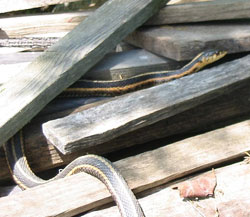 In an attempt to try and limit snakes entering areas considered ’off limits’ go and ask your French neighbours. They have been dealing with this problem all their lives and in most cases will have found a number of methods that work. One method that is used a lot in the ville we live in, is to purchase a product containing the chemical ammonia. Then spraying the ammonia around the edge of the building that you want ’unoccupied’. As to how often you perform this task between now and the end of October is down to you, also remember that wildlife and nature are resilient, enterprising and smarter than us humans, so there is no 100% guarantee that this method will work.
In an attempt to try and limit snakes entering areas considered ’off limits’ go and ask your French neighbours. They have been dealing with this problem all their lives and in most cases will have found a number of methods that work. One method that is used a lot in the ville we live in, is to purchase a product containing the chemical ammonia. Then spraying the ammonia around the edge of the building that you want ’unoccupied’. As to how often you perform this task between now and the end of October is down to you, also remember that wildlife and nature are resilient, enterprising and smarter than us humans, so there is no 100% guarantee that this method will work.
Apples and pears, need I say more ? Please do not be tempted to take that apple from that tree and have a bite (does this sound familiar ?). If the serpent does not bite you, the one in your eagerness to get the apple you failed to see, then the farmer will. Pure and simple, it’s a crime which farmers and the authorities take very seriously.
Mushrooms, September is the season of the Cepes and make no mistake; it is revered and sought after with a passion like no other in this area of France. July and August have been very dry, therefore, there is a probability that cepes are going to be scarce and subsequently expensive in the shops.
As with all mushrooms, please, please, please know what you are doing as the similarities between what you can eat and enjoy and what can kill you is too fine for my liking.
Rule of thumb, unless you are 100% sure that its OK to eat, leave it in the ground. One other little reminder, be careful when you go looking for mushrooms, as mushrooms have this habit of growing where wildlife lives.
Garden fires. So it may have been raining for the past 3 days, its got to be safe to light a fire now ? DON’T EVEN THINK ABOUT IT. It is still going to need a lot more rain to make it safe. Again, go down to your Mairie and ask what date he/she will allow you to light your garden fire.
Yes I know, every British Islander must have seen it (The French O.A.P. burning all sorts in the middle of August) then had this thought (how come they can have a fire). The short answer is because they can, they knows more than you, they may have a special dispensation that allows them to, or they may just simply have asked their mairie if they can.
Wood for winter fires, now is a good time to get your fuel.
And this year, make the provision for storing the ashes from the fire as you will be needing it for your garden next spring, which isn’t really that far away and also for this time next year.
OK, now the basics have been discussed lets look at what needs to be done in the garden.
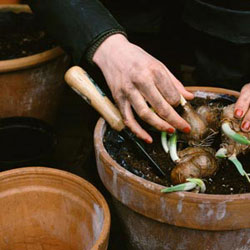 Bulbs, the Autumn and any Winter varieties should be planted. As discussed last month, the bigger the better if you prefer the big showy type of flowers, they do cost more, a lot more. So if spare cash is an issue consider smaller or home grown additional stock, which carefully planted in little nooks and cranny’s, will really brighten up the garden next spring.
Bulbs, the Autumn and any Winter varieties should be planted. As discussed last month, the bigger the better if you prefer the big showy type of flowers, they do cost more, a lot more. So if spare cash is an issue consider smaller or home grown additional stock, which carefully planted in little nooks and cranny’s, will really brighten up the garden next spring.
Spring bulbs will need planting in about six weeks time, for most of us it will be crocus, hyacinth and tulips. If you already have these bulbs you may want to try the following for a better flower show next year. Place the bulbs in a brown paper bag and put them in the salad compartment of your fridge. Store them for 6 weeks prior to planting, though a word of warning, do not store them with apples (keep them away), which could be a problem around the Limousin.
When planting remember, a large planting of a single flower type or colour really shows off your work in the garden, compared to mixed colours. Also consider the shape of your planting and always try to use a back ground that contrasts well with the colours you intend to plant i.e. Daffodils against your Leyland hedge, or, red tulips surrounded by a blanket of yellow or white pansies. The choice is yours.
Other spring flowering bulbs you may want to consider are, Dutch iris, freesia, anemone, oxalis, ranunculus, watsonia, and hyacinth to name only a few.
One final tip about bulbs, If you are not sure which end of the bulb is the top, plant it on its side. The stem will always grow upright.
Planting, seasoned vegetable and flower gardeners will know that two weeks prior to planting that the beds need to be prepared. Existing beds will need amending (larger or smaller), rotovating or digging over and fertilizing like crazy.
Some examples of winter crops are, beetroot, cauliflower, Brussels sprouts, cabbage, broccoli, chives, celery, onions, parsley, parsnips, peas, radish, spinach, lettuce, and turnips,
the list just continues.
As with new or existing beds determine if you require to add lime, check the soil and see if it is acidic and needs lime.
New beds will need to be dug and left over the winter to let nature do what it does best, cold frost and water breaking down the rough soil, (but you can cheat).
Add lime if needed, get plenty of organic matter (a good place to put your leaves) and fertilizer (yes see the farmer it really is better if its ’natural’) in with the dig. You may find that the best way to get your beds right is to do it in stages as you have to get a lot to happen in 6 months. Once you are happy with the bed you may want to plant a cover crop or ’green manure’ into it.
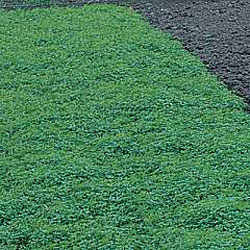 This basically is a crop that should be left to grow and then die. Then the remains should be dug in hence the term green manure. An example of this is the following, how many times in the UK/B Isles did you pass a field mid Jan to mid Feb and notice an odour in the air ? Yes its all coming back now !!!.
This basically is a crop that should be left to grow and then die. Then the remains should be dug in hence the term green manure. An example of this is the following, how many times in the UK/B Isles did you pass a field mid Jan to mid Feb and notice an odour in the air ? Yes its all coming back now !!!.
Good cover crops based on my experience of their odour are brussels sprouts, cauliflower and cabbage. If you are thinking about eating the produced from this first crop, that is something you will have to decide, some say yes, the purist will say no. By the way, this is also a great way to get your flower beds ready.
If you want to get some of your herbs to go a little longer, why not pot some of the smaller plants and bring them into the house. Though, remember this, tap water in your house will not be the best type of water to water them with. Tap water has sodium, chlorine and all sorts of other ‘stuff’ in it. Either way the sodium alone will be enough to sit in the soil and either damage or kill the herbs. This also goes for your house plants, ever wondered why you can keep some house plants and not others? This Christmas ask for a water butt if you haven’t got one already.
Trees and shrubs, leaves will begin to fall, get them off the grass and into the new beds or composter. Now is a good time to move trees if you can or plant new ones. Reason being their roots will continue to grow until the ground freezes and this applies to both evergreens and deciduous plants.
Start taking cuttings of your annual plants to bring indoors and carry on through the winter. Geranium, coleus, fuchsia, and other plants do best when stem cuttings are rooted and kept in pots indoors through out the winter. Be sure to place pots where they receive plenty of light.
As discussed last month. Plant peonies now (depending on variety), but make sure the crowns are buried only 1 1/2 to 2 inches (3 to 5 cm) below ground level. Deeper planting keeps the plants from blooming.
Maintenance, Autumn is a probably the best if not greatest time to plant and divide perennials, (and don’t forget shrubs) for next year’s garden. By planting in the Autumn, your plants are not subjected to the long stressful summer heat during their establishment and gives them the time to form a sufficient root systems before the onset of winter dormancy.
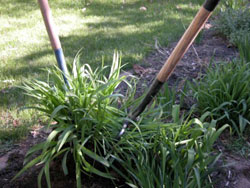 Dig, divide and re-plant over-crowded perennials that have finished flowering like agapanthus, daylily, penstemon, and coreopsis to name a few.
Dig, divide and re-plant over-crowded perennials that have finished flowering like agapanthus, daylily, penstemon, and coreopsis to name a few.
If your tuberous begonias are beginning to show signs of mildew, stop watering and let them dry off, then dig them up and allow them to dry out, After drying store them for the winter in a cool, dark place.
As the nights become cool, caladiums and other warm summer bulbs will begin to lose leaves. Dig them up, allow them to dry, But with these store them in a warm dry place.
Annuals that like cool weather are, pansy, viola, snap-dragon, stock, calendula, Iceland poppies and California poppies (if you can get them). If you haven’t got these sowed yet, you can take a chance but hurry up.
Have on hand some heavy material, be it a blanket, garden fleece or cardboard boxes to cover tender garden plants on the first nights of frost. Often if tender plants can be protected from early frosts, they will bloom for several more weeks.
Greenhouse owners will know this, but, when using a green house or cold frame to extend your harvest season, be sure to close the top on frosty nights to protect the plants from the cold. When the sun comes out the next morning and the air warms, open the cold frame again.
As your annuals fade away and return to you your pots, remember its important to clean the pots/containers as quickly as possible. This is to reduce the risk from spreading diseases and insect pests, part one is to sterilize old flower pots by soaking for a few hours in a solution of one part bleach to nine parts water. Part two is to soak the pot in clean fresh water prior to re planting.
The Lawn. Your mower still has a lot to do so do not put it away. As long as your grass grows cut it. Here in the Limousin you can start to look at stopping cutting around late November.
Look at filling in and re-seeding divots and bald patches (normally caused by moles, sounds familiar….again). Fertilize your lawn well as it has had a hammering this summer, but before you do, while its still relatively dry, give it a treat and scarify it, also a little spiking wouldn’t hurt either. Get this done quickly as you will need to look at what you have to do with the weeds as I think I‘m safe in saying that a weed and feed treatment here, will only go so far and you may want to consider a more effective manner of weed control.
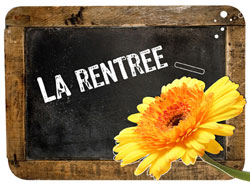 Two final things to consider, you may want to be getting some hay to lay over your lilies or other plants that will need protection this winter, now is a good time to do that.
Two final things to consider, you may want to be getting some hay to lay over your lilies or other plants that will need protection this winter, now is a good time to do that.
Secondly, keep your garden journal up to date. The aim of your journal is to make a long-range plan to gradually convert your current landscape to the one you desire.
Don’t pull out any ornamental plantings until you have the time and resources to replace them.
As you can see, September is not as sleepy as we thought and you can now see the importance of “La Rentrée” and how it makes a far more sensible ‘new year’ than the one the calendar suggests.
Well that is it for now, happy gardening and see you next month.
Mark
Article kindly provided by Mark from Oak Garden Services
You can contact Mark directly if you would like more information on gardening or the services they offer
Tel: 05 55 98 62 03
Email: oakgs@yahoo.fr
Share to: Facebook Twitter LinkedIn Email
More in children, courses, events, holiday accommodation, renovation, schools, summer
By FrenchEntrée
Leave a reply
Your email address will not be published. Required fields are marked *

